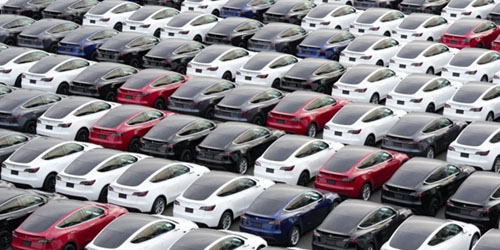
Vehicle Electrification is Not
Necessarily One-Way Traffic for PGMs.
Slower BEV sales growth incentivises hybrids to pick up the slack. The Tesla Model Y was 2023’s best-selling passenger vehicle with 1.24 million units sold. BEV sales are forecast to grow faster than the growth in the total light-vehicle market this year, and this is expected to cut global palladium autocatalyst demand by 5% to 7.4 moz, potentially weakening prices further, notes analyst Marc Loeffert at Heraeus Precious Metals. There are a number of risks to this growth in BEVs, however, that could lessen palladium’s downside if consumers move in greater numbers to catalyst-containing hybrids (mild, full & plug-in).
Policy changes could check BEV’s accelerated growth. In Europe, Germany has cut subsidies for business and personal BEV purchases, and France’s revamped government schemes exclude most cheap Chinese models. BEV sales in Europe grew by 37% year-on-year last year, while hybrids (HEVs + PHEVs) saw more moderate growth of 19% year-on-year, albeit with more than twice the sales volumes of 3.53 million units vs. 1.54 million for non-catalysed cars (source: ACEA). With reduced financial support in major markets this year, the growth rate of EV sales could slow, though it is likely to remain robust.
US automakers are tempering BEV production plans. Ford has halved its F-150 Lightning production plans, and GM has delayed production ramp-up for at least three BEV models and lowered its cumulative BEV production goal of 400,000 units by the end of this year. The US market is experiencing more obstacles to adoption than other major auto markets, many of which PGM-loaded hybrids can overcome, e.g. range and cost. PHEVs can easily deliver more than 500 miles of range while BEVs generally fall short of this, and do not meet consumer expectations. While IRA credits can apply to both BEVs and PHEVs, hybrids have consistently lower upfront costs. These factors contributed to sales growth and volumes of hybrids outperforming BEVs in the US market in 2023.
Alternatively, recessions mean lower total car sales but BEVs could be less impacted. The data suggests premium light-vehicles’ sales tend to hold up better in recessions that non-premium vehicles. If the US and Europe were to slip into a recession this year, counterintuitively this could favour BEVs over ICE vehicles, as BEVs tend to occupy a higher price bracket. A recession would likely have a net negative impact on autocatalyst PGM demand, as total vehicle production numbers would fall, and this could be compounded by increasing non-catalysed vehicle market shares.
Editor’s Note: Heraeus Precious Metals is globally leading in the precious metals industry. The company is part of the Heraeus Group and covers the value chain from trading to precious metals products to recycling. In addition to gold and silver, it also has extensive expertise in all platinum group metals.
The Resource Investor
Copyright 2023-25 |
All Rights Reserved
Reproduction in whole or part
is strictly prohibited
without
prior written permission
NOTE: The Resource Investor
does not itself endorse or guarantee
the accuracy or reliability of
information, statements or opinions
expressed by any individuals or
organizations posted on this site
PLEASE READ DISCLAIMER
Web Site Designed
& Maintained by
Gemini Communications
This website is a publication of the
Bull & Bear Media Group, Inc.
Info@TheBullandBear.com
















